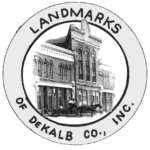By James R. Kuykendall / Published in the Landmarks News, 1994, The DeKalb Legend Volume 1

In 1940 there was a total of 510 telephones in all of Fort Payne. My home phone was 121–J and Haralson Drug’s was 48, but we often just picked up the phone and said, “I want the Sheridan Lowery residence.” The reply from the operator might well have been, “Oh, they are not at home; they’ve all gone to Chattanooga.” It was a very personal, folksy relationship and we loved it.
Fort Payne’s first telephone service in 1900 had 37 subscribers. The exchange was owned and operated by Cumberland Telephone and Telegraph Company. Southern Bell purchased the Fort Payne exchange with its 66 subscribers in 1904, according to the Historical Record of Exchanges of South Central Bell.
Before becoming part of the Bell system, the Fort Payne office was located in the McGee Building of First Street. Maggie McSpadden Pendergrass was the first operator, according to Sarah P. Sawyer.
Maude Hicks, the first chief operator for the Southern Bell Telephone and Telegraph Company, lived in a one–room apartment behind the telephone office located on the second floor of the Sawyer building. She remained there until the ofice was enlarged, when she moved to the nearby DeKalb Hotel. According to Mrs. Sawyer, Maude Hicks allowed her clothing and belongings to be burned in the hotel fire of 1918 rather than leave her duties as chief operators.
Another operator, Rhoda Wilson, was a close associate of Maude Hicks during the thirties and forties. When people talk aboaut the Telephone days at the Sawyer Building, the names of Maude Hicks and Rhoda wilson automatically come to mind.
Rhoda Wilson, who married in 1949 and moved to Oklahoma, died in 1973 in Rossville, Georgia. Maude Hicks died in 1952. Tressie Strange, who was named chief operator, served util the dial system was installed in April 1961. Virginia Lankford Kitchens was assistant chief operator during this time.
